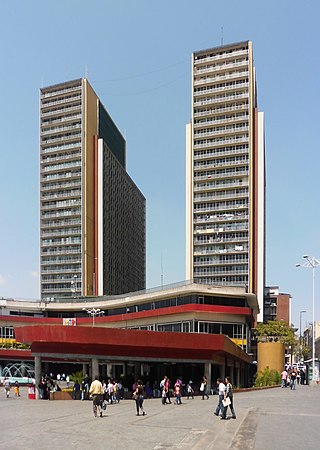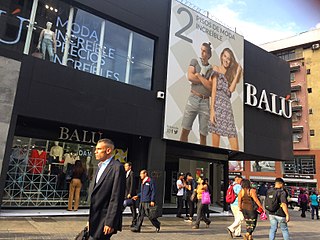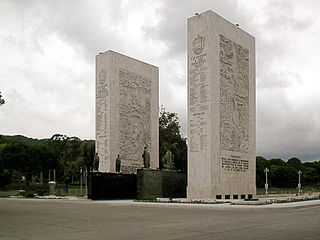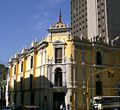
Aragua State is one of the 23 states of Venezuela. It is located in the north-central region of Venezuela. It has plains and jungles and Caribbean beaches. The most popular are Cata and Choroni. It has Venezuela's first national park which is called Henri Pittier. The capital is Maracay, other important cities include Turmero and El Limón.

Luis Ángel Arango Library is a public library located in Bogotá, Colombia. It is one of the largest and most important libraries in the world. It was founded in 1958 as a small library with a few books on economics, currently its collection has about 2'000.000 works. Today the library has been expanded and occupies two entire city blocks spanning about 45,000m². Its collection has grown to become the country's premier library and has come to be considered the most important public library in Latin America, and one of the most visited in the world. It has over 1.1 million books and seating for 1900 readers; it received 6.7 million visitors in 2008. The library is named after the lawyer and businessman Luis Angel Arango, the general director (Governor) of the "Banco de la Republica" in Colombia from 1947 to 1957, and a champion of culture and literature for all. The library is part of the cultural affairs wing of Colombian Central Bank, Banrepcultural network, which today runs 23 additional libraries, cultural centers and museums across Colombia.

Chacao is one of the five political and administrative subdivisions of the city of Caracas, Venezuela. The other four are Baruta, El Hatillo, Libertador and Sucre. This legal entity is known as the Caracas Metropolitan District. Chacao is also one of the 21 municipalities that make up the State of Miranda, Venezuela.

Carlos Raúl Villanueva Astoul was a Venezuelan modernist architect. Raised in Europe, Villanueva went for the first time to Venezuela when he was 28 years old. He was involved in the development and modernization of Caracas, Maracay and other cities across the country. Among his works are El Silencio Redevelopment which included 7797 apartments and 207 shop premises and the Ciudad Universitaria, the main campus of the Central University of Venezuela. The Campus was declared a World Heritage Site by UNESCO in the year 2000.

The historic center of Mexico City, also known as Centro or Centro Histórico, is the central neighborhood in Mexico City, Mexico, focused on Zócalo or main plaza and extending in all directions for a number of blocks, with its farthest extent being west to the Mexico City Alameda Central. The Zocalo is the largest plaza in Latin America. It can hold up to nearly 100,000 people.

Banesco Banco Universal C.A. is a Venezuelan financial institution whose principal branch is located in Caracas. The bank is part of the Asociación Bancaria de Venezuela.

Banco Occidental de Descuento (BOD) (WDB) was a Venezuelan bank. With around 6.6% of the Venezuelan market, it was Venezuela's fifth-largest bank in 2009.
The Mercantil Tower is a skyscraper located in the Venezuelan city of Caracas, is known for being the fourth tallest tower in the city and the country with 179 m in height and 40 floors, is located at Avenida Andres Bello, Candelaria Parish of Libertador municipality northwest of the capital.

The Centro Simón Bolívar Towers TCSB also known as the Towers of Silence is a building with a pair of 32-story towers, each measuring 103 meters in height, in El Silencio district, Caracas, Venezuela. Built during the time of the presidency of Marcos Pérez Jiménez, the TCSB was opened to the public on December 6, 1954.

The BCV Building is an office building located on Avenida Urdaneta, Caracas, Venezuela and is the headquarters of the Banco Central de Venezuela. It is also the largest funder of the city and covers 27.000 m² at street level. The building was completed in 1965 and was opened the same year; a second compound was built in 1967, which is a tower that reaches 117 meters high and has 26 floors.

The Palacio Municipal de Caracas, or Consejo Municipal de Caracas, is the city hall of Caracas, Venezuela. It is located on the corner of Gradillas a Monjas opposite the Plaza Bolívar, occupying half of the plaza's southern section. The building dates from the seventeenth century but now bears the mark of Alejandro Chataing's Neoclassical additions in 1906. It was the focal point for the Constitutional Convention, and signing of the Declaration of Independence in the nineteenth century. The present building is the result of the work undertaken by the Venezuelan architect Alejandro Chataing in 1906. The west wing of the building, the Capilla de Santa Rosa de Lima, the chapel where Venezuela's independence was declared in 1811, has been fully restored and furnished with authentic period pieces. The ground floor houses the Museo Caracas, which contains works by Venezuela's most celebrated painters and many other historic artifacts. It was declared a National Historic Landmark on 16 February 1979.

The Palacio de las Academias is a Neo-Gothic building on the Avenida Universidad in the centre of Caracas, Venezuela. It dates back to 1684 when a Franciscan convent was built on the site but in the 19th century it served as a barracks, a hospital and a college. In 1876, under President Antonio Guzmán Blanco, the Universidad de Caracas was moved to the building, whose former colonial façade was rebuilt in the Neo-Gothic style. After the university relocated to a new campus in 1952, the building became home to the National Academies. In 1965, it was listed as a national monument. The Palacio de las Academias now houses six National Academies, which are the National Academy of History, the Venezuelan Academy of Language, the Academy of Medicine, the Academy of Political and Social Sciences, the Academy of Jurisprudence, and the Academy of Physics, Mathematics and Nature.

The Palacio Federal Legislativo, also known as the Capitolio, is a historic building in Caracas, Venezuela which houses both the National Assembly and the National Constituent Assembly. Located southeast of the Plaza Bolívar, it was built between 1872 and 1877 by President Antonio Guzmán Blanco to a design by the architect Luciano Urdaneta Vargas. The Salón Elíptico, opened in 1877, is topped by a golden dome.

The Luis A. Ferré United States Courthouse and Post Office Building in Ponce, Puerto Rico, previously known as the U.S. Post Office and Court House, is a historic post office and courthouse facility of the United States, housing operations of the United States District Court for the District of Puerto Rico. It was the first U.S. postal office established in Puerto Rico.

The Palacio de Justicia de Caracas is a government complex straddling Avenida Bolívar in Caracas, Venezuela. It houses numerous courtrooms and judicial facilities serving the metropolitan area. Designed by Carlos Gómez de Llarena in 1983, it became functional in 2004.

The Boulevard of Sabana Grande is an important leisure and shopping area located in eastern Caracas in the geographic center of the Metropolitan District of Caracas. It is a pedestrian-only, tree-shaded public space. In 2011, the boulevard of Sabana Grande went through a rehabilitation process founded by PDVSA La Estancia. A commercial and financial district, Sabana Grande is the commercial corridor, and a tourist district of Caracas. The boulevard of Sabana Grande is home to the most important ornithological collection in Latin America, the William Phelps Ornithological Collection. Until the beginning of the 20th century, it was called Calle Real because it was the town's main road.

The Casa Amarilla de Caracas is a 19th Century neoclassical building in Plaza Bolívar, Caracas and in front of the Santa Ana Cathedral, in the city's main historic quarter.

The Paseo Los Próceres is a monument located in the Venezuelan city of Caracas, near Fort Tiuna and the Military Academy of the Bolivarian Army. On the promenade there are statues of the heroes of the War of Independence, as well as fountains, stairs, squares, roads and walls. Since 1993, the Paseo Los Próceres and the entire annex system was declared a National Historic Landmark.

Fuerte Tiuna or Fort Tiuna is the name given to one of the most recognized military installations in the city of Caracas and the South American and Caribbean country of Venezuela.























